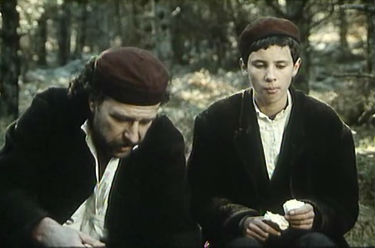Cinematic Identities... GENDERED GAZE
|
Similarly to Karanović, Živko Nikolic returns to rural geography and culture, which enables him to employ other strategic possibilities during the growing crisis of film production in Montenegro and Yugoslavia in the 1980's. The common theme of most Nikolić's films is his protagonists' inner tensions which reflect a conflict between personal psychological needs and public patriarchal constraints. The plot twist usually coincides with the woman's repossesion of the gaze in the highly patriarchal local setting. Such authorial cinematic gaze on female gender defies the traditionally established gender classifications and has a powerful impact of its social critique on the local context. The most consistent and simultaneously controversial feature of Nikolic's films is his representation of women who embark on their journey of liberation, symbolically, and of their gaze-repossesion, cinematically, and who, empowered by the sexual difference, self-consciously take pleasure in celebrating their body of the other (Luka's Jovana, Unseen Wonder, and particularly The Beauty of Sin). Nikolic's works suggest the possibility of a mode of spectatorship in a reversed masquerade, which produces the possibility of alternative identities. To elaborate on a challenging model of the male gaze on patriarchy, the concept of reversed masquerade is particularly useful. The director uses visual and linguistic signs to underscore patriarchal attitudes, not only of men, but also of elderly women, who appropriated such attitudes from their fathers and, later, husbands. Nikolic's female characters reverse Rivière's notion of feminine masquerade (1986) and, as such, cannot bear any signification of female subjectivity. Their entrance into the collective sphere depends on the effacement of any feminine qualities: the female nudist resort manager is the representative of communist masquerade for 'manliness'; androgynous looking moustached mothers and grandmothers, almost regularly dressed in black |
(»babe«), cast the sadistic voyeuristic gaze on both men and women. Contrary to Rivière's concept of excessive womanliness, the local female characters use traditional masculinity as a mask disguising and effacing their feminity. By doing this, they precisely accentuate their masculine side and engender a masqueraded indentity as neither a 'man' nor a 'woman'. These reversely masqueraded heroines are portrayed with more distortions and as being more cruel than their male counterparts. In such a perspective of masqueraded identities, there are no heroic saviours in Nikolic's films and here lies his main subversion of the Montenegrin myth of »manhood and heroism« (»čojstvo i junaštvo«). All his male characters are a reversal of this myth. They are rather presented as conflicted figures who consciously (as representatives of the dominant ideologies) or unconsciously (as members of the rural community) cowardly enact traditional ethical standards. Whereas other Yugoslav mainstream narratives expose socially oppressed classes, focusing on women in particular as 'primitive materials', in Nikolic's work, it is both women and men who are seen as 'primitive materials'15. Foregrounding comic effects of the Bakhtinian concept of carnivalised folklore tradition, Nikolić succeeds in reaching the wider audiences, both domestic and international, and in »reconciling the commercial with the antropological«, which was his personal aim, stated on many occasions16. His gaze shift shows that the active-male/passive-female dichotomy is not only reversible, but that a male character can also undergo a transformation. However, the originality of Nikolic's perspective lies precisely in his depiction of gender relations that do appear as the direct product of a patriarchal structure, and not only of socio-political power relations, and in his subsequent critique of such structures of domination and subordination: without reserve or distancing techniques, he displays and confronts these patriarchal structures. |

----------------------------------
15 Herzfeld, 2004, my translation
16 see Jelušić & Jelušić, 2006

